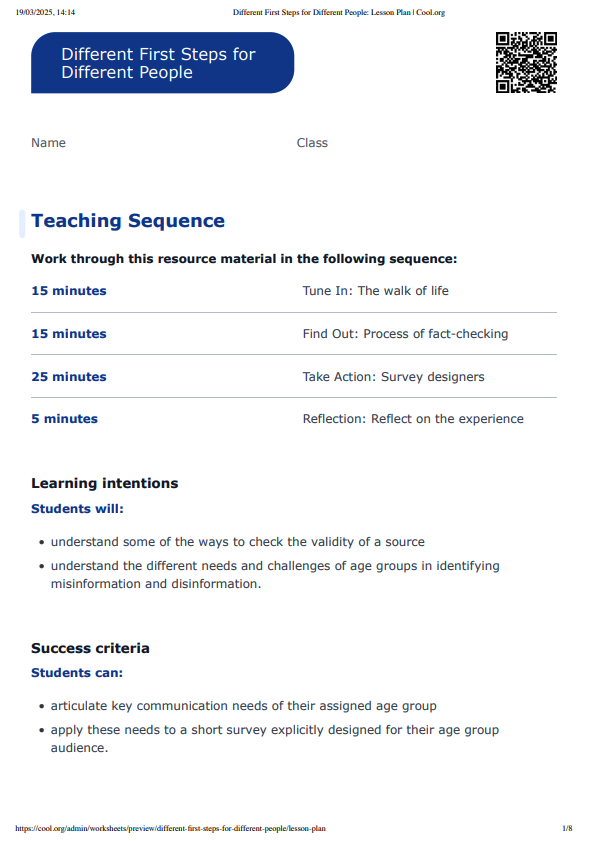Lesson summary
Students will use their knowledge of identifying misinformation and disinformation to develop a survey designed for a specific age group in Australian society. The survey will determine how their assigned age group consumes media and fact-checks information.
Learning intentions
Students will:
- understand some of the ways to check the validity of a source
- understand the different needs and challenges of age groups in identifying misinformation and disinformation.
Success criteria
Students can:
- articulate key communication needs of their assigned age group
- apply these needs to a short survey explicitly designed for their age group audience.
Lesson guides and printables
Curriculum links
Select your curriculum from the options below.
Lesson details
Skills
This lesson is designed to build students’ competencies in the following skills:
- creative thinking
- critical thinking
- collaboration
- communication
- empathy
- reflection
- social skills
Curriculum Mapping
Australian Curriculum (v9.0) content description:
Year 9, Civics and Citizenship
Students learn to:
- create descriptions, explanations and arguments using civics and citizenship knowledge, concepts and terms that incorporate evidence (AC9HC9S05).
Year 10, Civics and Citizenship
Students learn to:
- create descriptions, explanations and arguments using civics and citizenship knowledge, concepts and terms that incorporate evidence (AC9HC10S05).
Relevant parts of Year 9 Civics and Citizenship achievement standards: Students use civics and citizenship knowledge, concepts and terms to develop descriptions, explanations and evidence-based arguments.
Relevant parts of Year 10 Civics and Citizenship achievement standards: Students use civics and citizenship knowledge, concepts and terms to develop descriptions, explanations and arguments that synthesise evidence from sources.
NSW Syllabus outcomes:
A student:
- evaluates the roles and responsibilities of individuals within the Australian community (WE5-4).
General capabilities: Critical and Creative Thinking, Digital Literacy, Literacy, Personal and Social Capability, Ethical Understanding, Intercultural Understanding
Cross-curriculum priority: Sustainability
Level of teacher scaffolding: Medium – facilitate student discussion and identification of information needs for different age groups.
UN Sustainable Development Goals
- Target 4.7: By 2030, ensure that all learners acquire the knowledge and skills needed to promote sustainable development, including, among others, through education for sustainable development and sustainable lifestyles, human rights, gender equality, promotion of a culture of peace and non-violence, global citizenship and appreciation of cultural diversity and of culture’s contribution to sustainable development.
Resources Required
- Device capable of displaying audiovisual material
- Paper for taking notes (1 per group)
- Student devices
- Whiteboard
Additional Info
Cool.org thanks our philanthropic funder, Boundless Earth for their generous contributions and collaboration in creating these resources.


Welcome back!
Don't have an account yet?
Log in with:
Create your free Cool.org account.
Many of our resources are free, with an option to upgrade to Cool+ for premium content.
Already have an account?
Sign up with:
By signing up you accept Cool.org's Terms and Conditions(Opens in new tab) and Privacy Policy(Opens in new tab).